Research on Bending Performance of Concrete Sandwich Laminated Floor Slabs with Integrated Thermal and Sound Insulation
Abstract
:1. Introduction
2. Experimental Study
2.1. Design and Fabrication of Specimen
2.2. Test Methods
2.3. Measuring Point Layout
3. Results and Discussions
3.1. Failure Characteristics
3.2. Bending Performance Analysis
3.2.1. Verification of Plane-Section Assumption
3.2.2. Load-Mid Span Deflection Relationship
3.3. Load-Reinforcement Strain Relationship
4. Analysis of the Slip Resistance of Sandwich Laminated Floor Slabs
4.1. Premise of Analysis
4.2. Anti-Slip Performance before Cracking
4.3. Anti-Slip Performance in Limit State
- (1).
- Before cracking, the cracking moment error between the calculated and measured values is not larger than 7% under the fully composite state, and there is no relative slip, indicating good connection performance between the upper and lower concrete.
- (2).
- When it reaches the ultimate state, the upper and lower concrete layers of the specimen are in a partially composite state. The reason is that the stirrup rebar is flexible and deforms under the transverse shear force, which results in the sliding effect and failure of co-working property.
- (3).
- The slip resistance of DBD01 under the damage stage is less than that of DBD02, which indicates that the slip resistance at the later stage of loading can be enhanced with the increase in reinforcement rate.
5. Finite Element Analysis
5.1. Damage Analysis of Sandwich Laminated Floor Slab
5.2. Comparative Analysis of Load-Deflection Curve, Load-Reinforcement Strain Curve, and Bearing Capacity
5.3. Effect of Post-Cast Layer Concrete Strength
6. Conclusions
- (1).
- The whole bending failure process of the sandwich laminated floor slab can be divided into three stages: elasticity, cracking, and failure. The demarcation points are concrete cracking and steel yielding, respectively. The bearing capacity of the sandwich laminated floor slab is significantly improved with the increase in reinforcement ratio. The normal use load, yield load, and the ultimate load with a larger reinforcement ratio are increased by 54.55%, 52.94%, and 46.46%, respectively. When the reinforcement ratio is increased, the late stiffness and the structural integrity are significantly improved. Moreover, the mid-span deflection decreases significantly with the increase in reinforcement ratio, and the cracking expansion is also delayed.
- (2).
- The pure bending section of the sandwich laminated floor slab conforms to the plane-section assumption under the action of two-point symmetrical loads. The anti-sliding performance results show that the prefabricated and the laminated layer are fully composite before cracking, and the common bearing can be realized. The specimen is partially composite when reaching the ultimate state, with the slip effect on the superposition surface.
- (3).
- The simulated and measured results accord well, which has the same variation of failure mode, load-deflection, and load-reinforcement strain. The difference between the simulated and the measured values of the ultimate load is less than 5%, which verifies the feasibility and effectiveness of the finite element analysis method. Further extending the analysis, the effect of the concrete strength of the post-cast layer on the normal use and ultimate load is not significant and can be neglected.
Author Contributions
Funding
Institutional Review Board Statement
Informed Consent Statement
Data Availability Statement
Conflicts of Interest
References
- Huang, L.J.; An, Q.; Geng, L.; Wang, S.; Jiang, S.; Cui, X.P.; Zhang, R.; Sun, F.B.; Jiao, Y.; Chen, X.; et al. Titanium Matrix Composites: Multiscale Architecture and Superior High-Temperature Performance of Discontinuously Reinforced Titanium Matrix Composites. Adv. Mater. 2021, 33, 2170039. [Google Scholar] [CrossRef]
- Kueh, A.B.H. Buckling of sandwich columns reinforced by triaxial weave fabric composite skin-sheets. Int. J. Mech. Sci. 2013, 66, 45–54. [Google Scholar] [CrossRef]
- Soufeiani, L.; Ghadyani, G.; Kueh, A.B.H.; Nguyen, K.T.Q. The effect of laminate stacking sequence and fiber orientation on the dynamic response of FRP composite slabs. J. Build. Eng. 2017, 13, 41–52. [Google Scholar] [CrossRef]
- Wang, S.; Huang, L.J.; An, Q.; Jiang, S.; Zhang, R.; Geng, L.; Qu, S.X.; Peng, H.X. Regulating crack propagation in laminated metal matrix composites through architectural control. Compos. Part B Eng. 2019, 178, 107503. [Google Scholar] [CrossRef]
- Ding, K.W.; Zhang, Y. Study on Composite Slab Structure. Appl. Mech. Mater. 2012, 214, 311–314. [Google Scholar]
- Wang, L.; Zhang, H.Y. Summary of Study on Composite Concrete Slabs. Appl. Mech. Mater. 2013, 2544, 695–698. [Google Scholar]
- Wang, Q.J.; Huang, X. Configuration and construction technology of the heat preservation sound insulation mortar. Concrete 2012, 5, 108–110. [Google Scholar]
- Joseph, J.D.R.; Prabakar, J.; Alagusundaramoorthy, P. Precast concrete sandwich one-way slabs under flexural loading. Eng. Struct. 2017, 138, 447–457. [Google Scholar] [CrossRef]
- Sharkawi, N.; Baharun, A. Effect of Different Types of Paint to Residential Building. J. Civ. Eng. Sci. Technol. 2016, 7, 68–74. [Google Scholar] [CrossRef]
- Bai, F.; Davidson, J.S. Analysis of partially composite foam insulated concrete sandwich structures. Eng. Struct. 2015, 91, 197–209. [Google Scholar] [CrossRef]
- O’Hegarty, R.; Kinnane, O. Review of precast concrete sandwich panels and their innovations. Constr. Build. Mater. 2020, 233, 117145. [Google Scholar] [CrossRef]
- Xu, D.F.; Chen, L.M.; Tao, S.N.; Cheng, S.C.; Xiao, F. The Study on Connector’s Mechanical Performance of Energy-Saving Precast Concrete Sandwich Panel Structure. In Proceedings of the International Conference on Energy Development and Environmental Protection, Shenzhen, China, 17–18 September 2016; pp. 100–106. [Google Scholar]
- Chen, Z.H.; Zhoum, T.; Lium, H.B.; Chen, Y.H.; Wang, X.D. Experimental and Theoretical Study on Structural Behavior of Fabric Reinforced Concrete Sandwich Panels. Adv. Sci. Lett. 2011, 4, 663–668. [Google Scholar] [CrossRef]
- Zhu, M.C.; Liu, Z.R.; Chen, Z.H. Performance analysis of prestressed concrete sandwich composite slabs. China Concr. Cem. Prod. 2001, 5, 47–49. [Google Scholar]
- Li, Y.B.; Du, Y.Y.; Men, D.H. Analysis on bending performance of concrete sandwich panels. Build. Struct. 2015, 45, 91–95. [Google Scholar]
- Chen, H.Q.; Xie, J.; Zhu, L.M.; Dai, Z.Q. Experimental Research on Flexural Performance of Concrete Sandwich Two-Way Panels Reinforced by Bi-Steel. J. Tianjin Univ. 2009, 42, 35–40. [Google Scholar]
- Luo, B.; Huang, W.; Ma, X.; Li, B.; Zhou, W.C.; Ren, S.S. Flexural behavior of sandwich composite panels with core material of expanded polystyrene thermal insulation motar. J. Zhejiang Univ. Eng. Sci. 2019, 53, 2185–2196. [Google Scholar]
- Joseph, J.D.R.; Prabakar, J.; Alagusundaramoorthy, P. Flexural behavior of precast concrete sandwich panels under different loading conditions such as punching and bending. Alex. Eng. J. 2018, 57, 309–320. [Google Scholar] [CrossRef]
- Joseph, J.D.R.; Prabakar, J.; Alagusundaramoorthy, P. Insulated precast concrete sandwich panels under punching and bending. PCI J. 2019, 64, 68–79. [Google Scholar] [CrossRef]
- Ahmad, A.; Singh, Y. Flexural behavior of Expanded Polystyrene core Reinforced Concrete Sandwich Panels with different construction methods and end conditions. Structures 2021, 34, 2900–2911. [Google Scholar] [CrossRef]
- Tomlinson, D.; Fam, A. Analytical approach to flexural response of partially composite insulated concrete sandwich walls used for cladding. Eng. Struct. 2016, 122, 251–266. [Google Scholar] [CrossRef]
- Xu, M.G.; Wang, X.; Ding, Z.W. Development of Out-Wall External Thermal Insulation System Based on Rock-Wool. Appl. Mech. Mater. 2012, 174–177, 1589–1592. [Google Scholar]
- Qi, B.; Zheng, C.; Lv, H.; Li, C.Z.; Le, B.L.; Zhang, F. Research and Application of Phenolic Resin in the External Thermal Insulation and Fire Resistance Composite System. Eng. Plast. Appl. 2012, 40, 28–30. [Google Scholar]
- Wang, L.; Jin, L.Z.; Wang, D.W. Experimental study on flexural behavior of UHPC aminated plates with different superimposed surfaces. J. Build. Struct. 2018, 39 (Suppl. S2), 43–51. [Google Scholar]
- Zhang, X.Y. Experimental research on factors influencing the rigidity of concrete composite slab with steel bar truss. J. Hefei Univ. Technol. Nat. Sci. 2014, 9, 1122–1126. [Google Scholar]
- De Seixas Leal, L.A.A.; de Miranda Batista, E. Composite floor system with CFS trussed beams, concrete slab and innovative shear connectors. REM Int. Eng. J. 2020, 73, 23–31. [Google Scholar] [CrossRef]
- Cheng, J.Y.; Zhao, L.; Yang, J.J. Study on Short-Term Rigidity of Precast Composite Slab with Steel Truss and Concrete. Adv. Mater. Res. 2013, 639–640, 198–205. [Google Scholar]
- Huang, W.; Luo, B.; Li, B.; Xu, X.K.; Su, Y.J. Experiment on Flexural Behavior of Green Concrete Composite Slab with Different Structural Forms. J. Hunan Univ. Nat. Sci. 2019, 46, 35–44. [Google Scholar]
- Huang, H.L.; Wu, F.B.; Zhu, M.Q.; Zeng, C.J.; Lv, W.R. Influence of rib details on flexural behavior of concrete composite slab with precast prestressed ribbed panel. J. Build. Struct. 2015, 36, 66–72. [Google Scholar]
- Thanoon, W.A.; Yardim, Y.; Jaafar, M.S.; Noorzaei, J. Development of interlocking mechanism for shear transfer in composite floor. Constr. Build. Mater. 2010, 24, 2604–2611. [Google Scholar] [CrossRef]
- Chen, Z.H.; Wang, J.; Cui, X.T.; Jiang, J.Q.; Wang, Z.Y.; Qiu, H.F.; Huang, Z.Y. Field test study on bearing capacity of assembled concrete composite slab. New Build. Mater. 2020, 47, 49–52. [Google Scholar]
- Hao, M.J.; Zheng, W.Z.; Chang, W. Evaluating Stress-Strain Properties of Reinforcing Steel for Reinforced Concrete. Adv. Civ. Eng. Mater. 2020, 9, 283–297. [Google Scholar] [CrossRef]
- GB/T 50081-2019; Standard for Test Methods of Concrete Physical and Mechanical Properties. National Standard of the People’s Republic of China: Beijing, China, 2019.
- GB 50010-2010; Code for Design of Concrete Structures. National Standard of the People’s Republic of China: Beijing, China, 2010.
- Ma, X.; Huang, W.; Luo, B.; Zhang, J.R.; Xie, H.Q. Reviews of concrete composite slabs—Mechanical properties and design methods. Concrete 2020, 364, 129–133. [Google Scholar]
- Huang, J.Q.; Xu, Y.Y.; Huang, H.; Dai, J.G. Structural behavior of FRP connector enabled precast geopolymer concrete sandwich panels subjected to one-side fire exposure. Fire Saf. J. 2022, 128, 103524. [Google Scholar] [CrossRef]
- Lameiras, R.; Barros, J.A.O.; Valente, I.B.; Poletti, E.; Azevedo, M.; Azenha, M. Seismic behaviour of precast sandwich wall panels of steel fibre reinforced concrete layers and fibre reinforced polymer connectors. Eng. Struct. 2021, 237, 112149. [Google Scholar] [CrossRef]
- Ma, S.; Hou, D.F.; Bao, P.; Wang, D.T. Influence of alkali-resistant glass fiber on seismic performance of precast ceramsite concrete sandwich wall panels. Structures 2022, 38, 94–107. [Google Scholar] [CrossRef]
- Xu, G.L.; Xu, Q.; Wang, J.X.; Qi, H.; Bai, Y.S. Uniaxial elastic-plastic damage constitutive model and parameters of concrete. J. Guangxi Univ. Nat. Sci. 2016, 41, 332–338. [Google Scholar]
- Dai, Y.; Nie, S.F.; Zhou, T.H. Finite element analysis of hysteretic behavior of square steel tube confined steel reinforced concrete column steel frame ring beam joint. J. Jilin Univ. Eng. Technol. Ed. 2018, 48, 1426–1435. [Google Scholar]
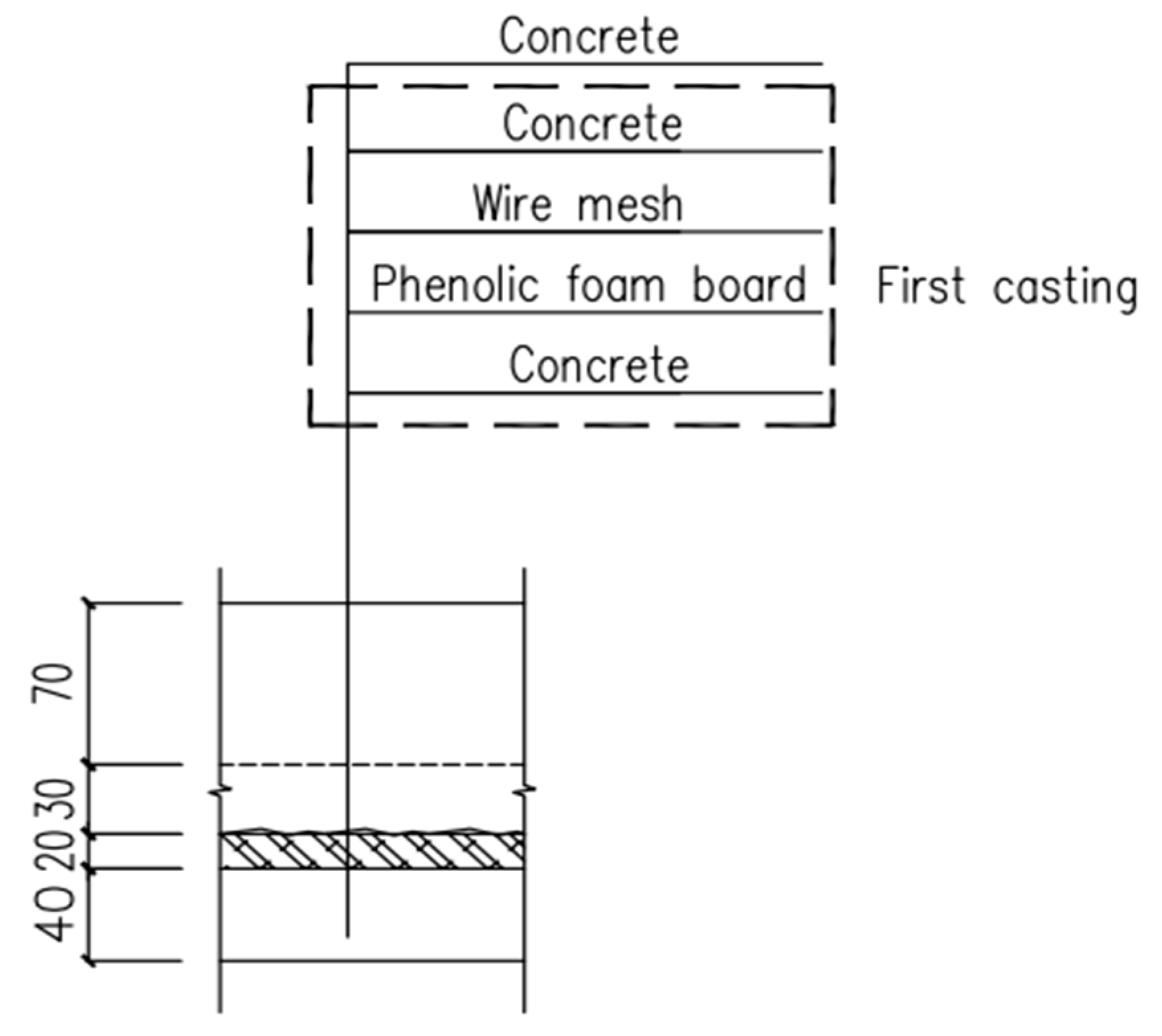
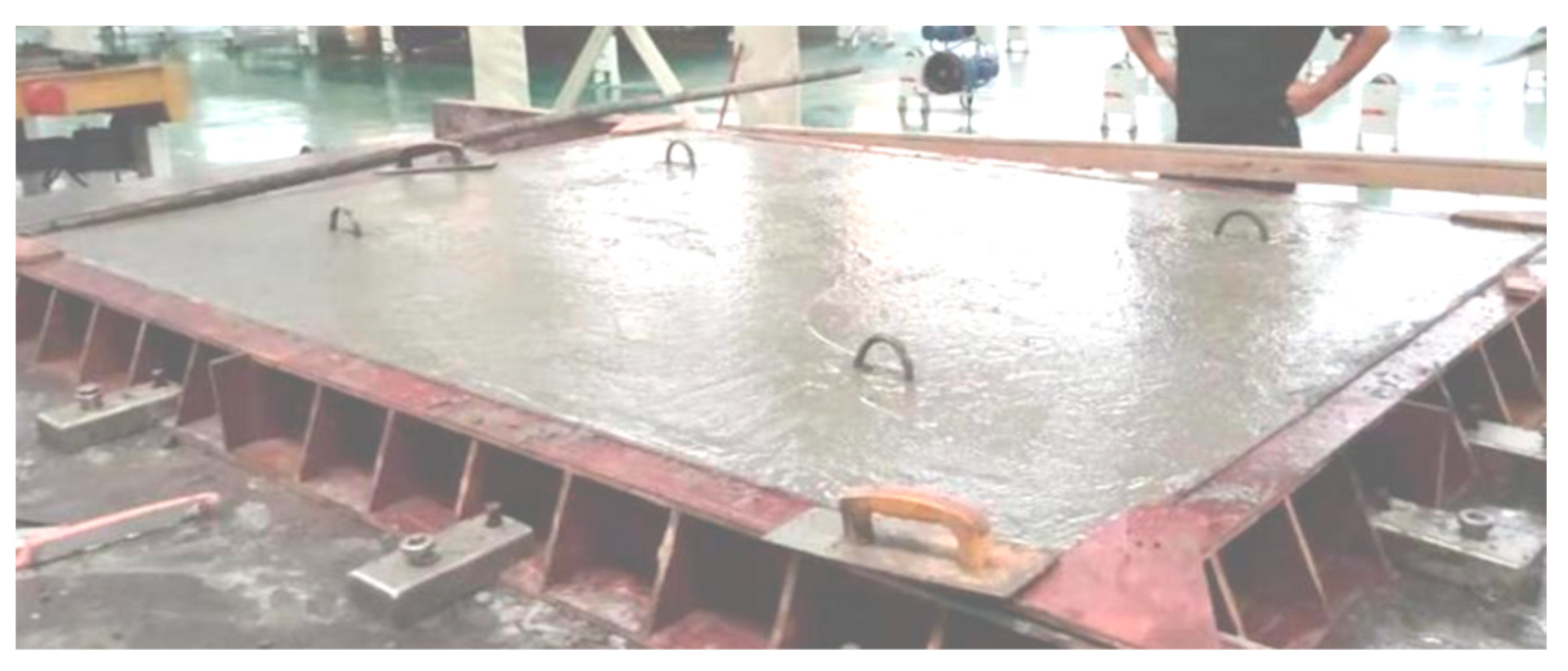
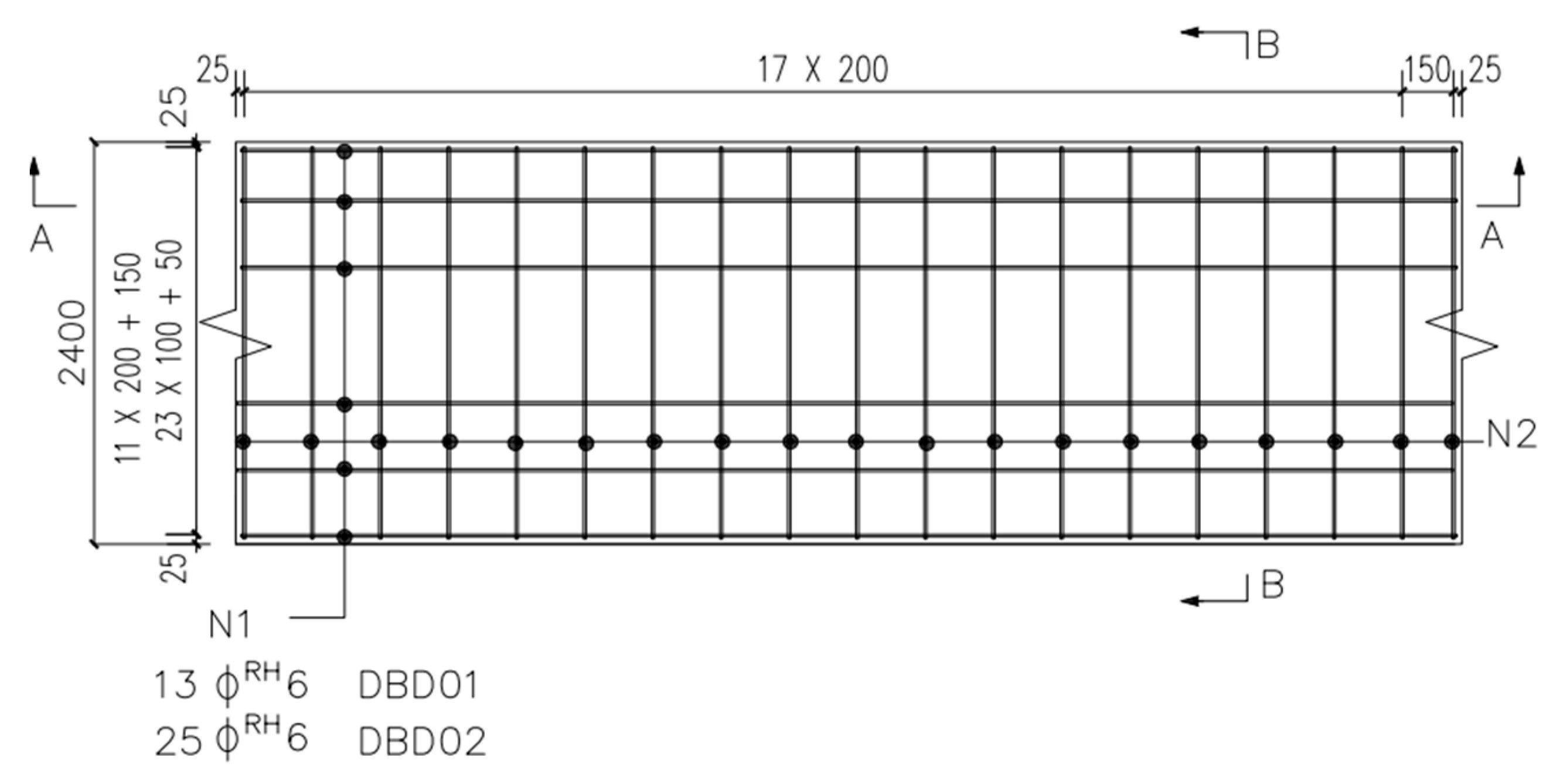

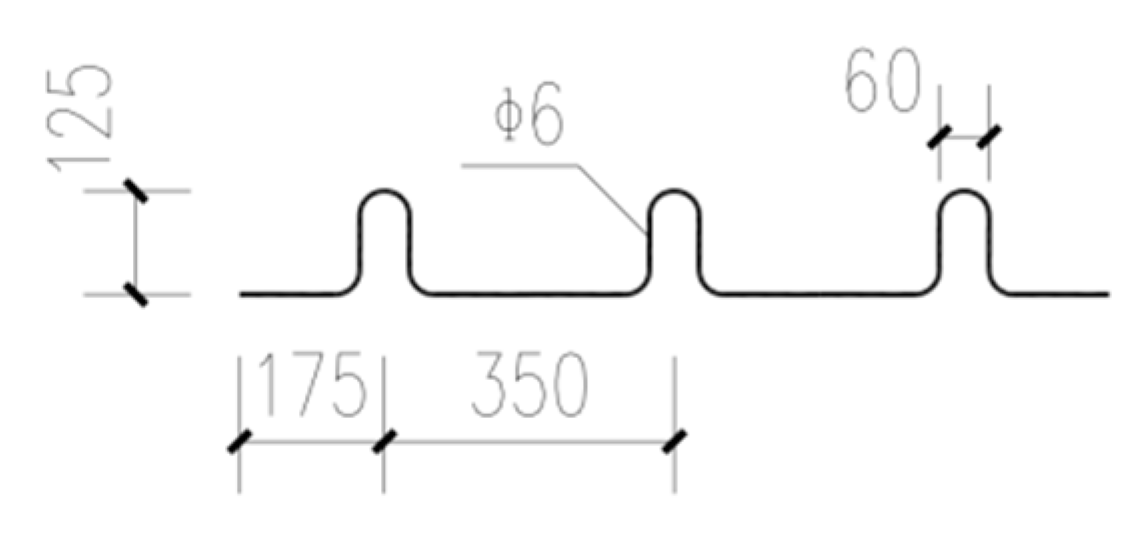
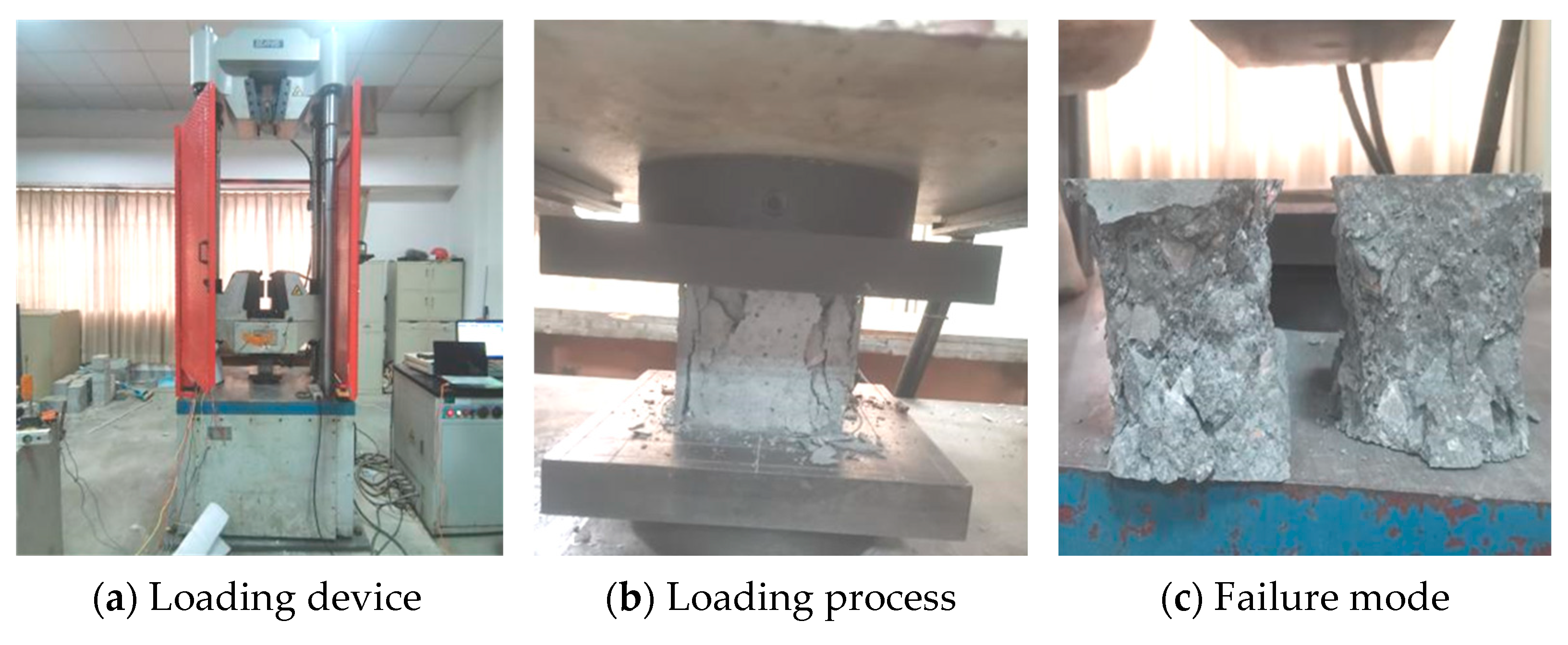
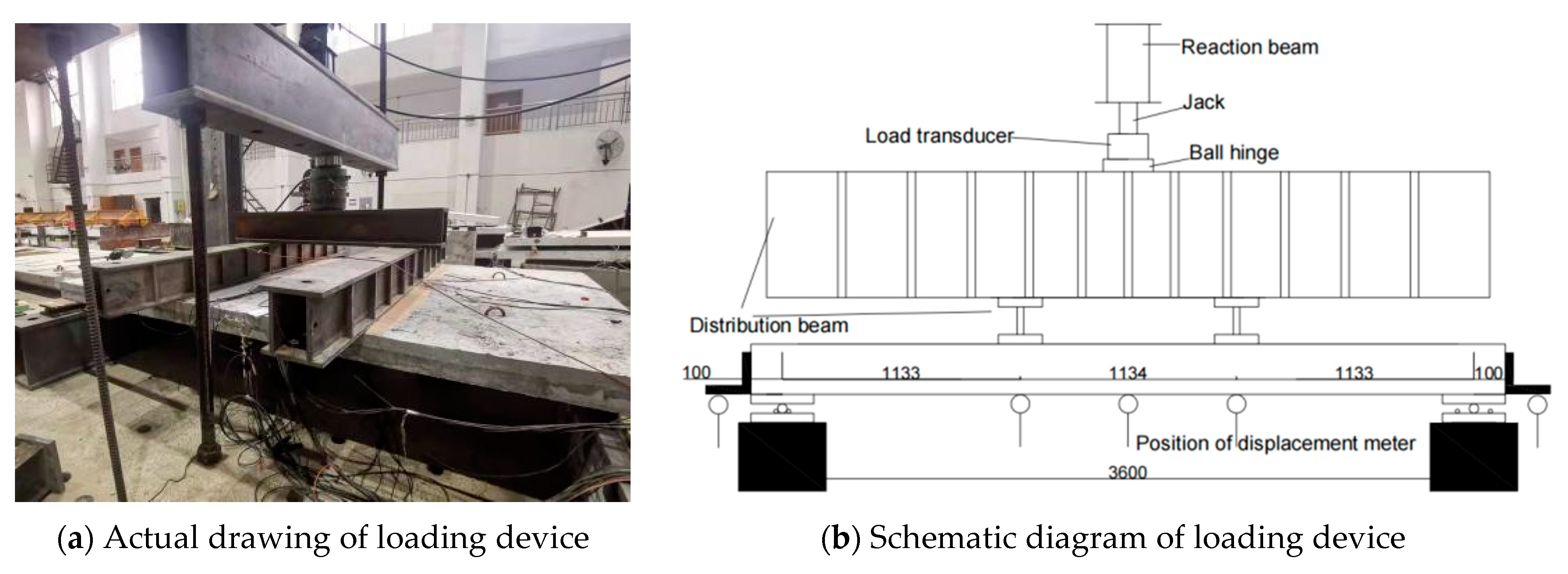
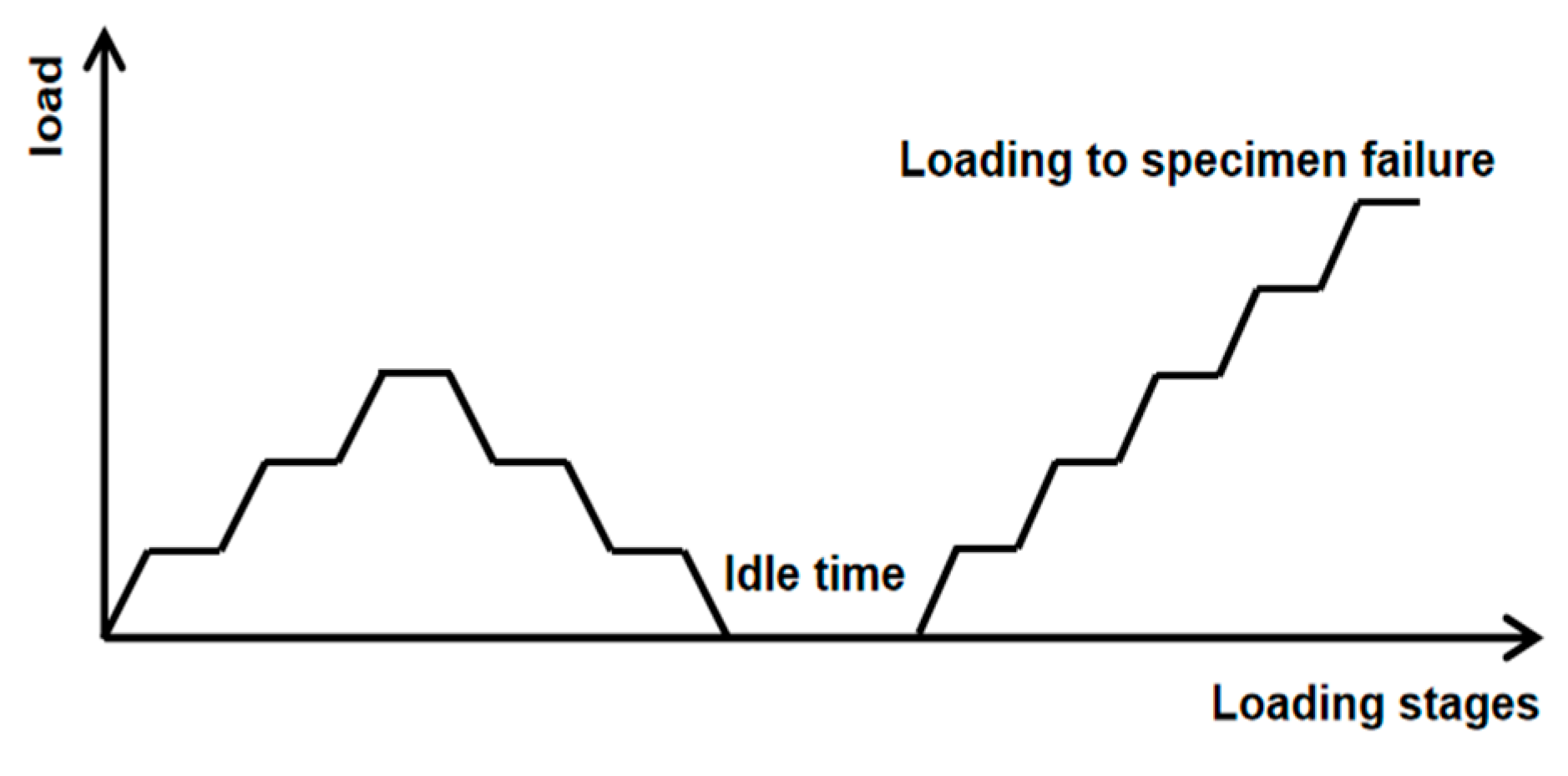
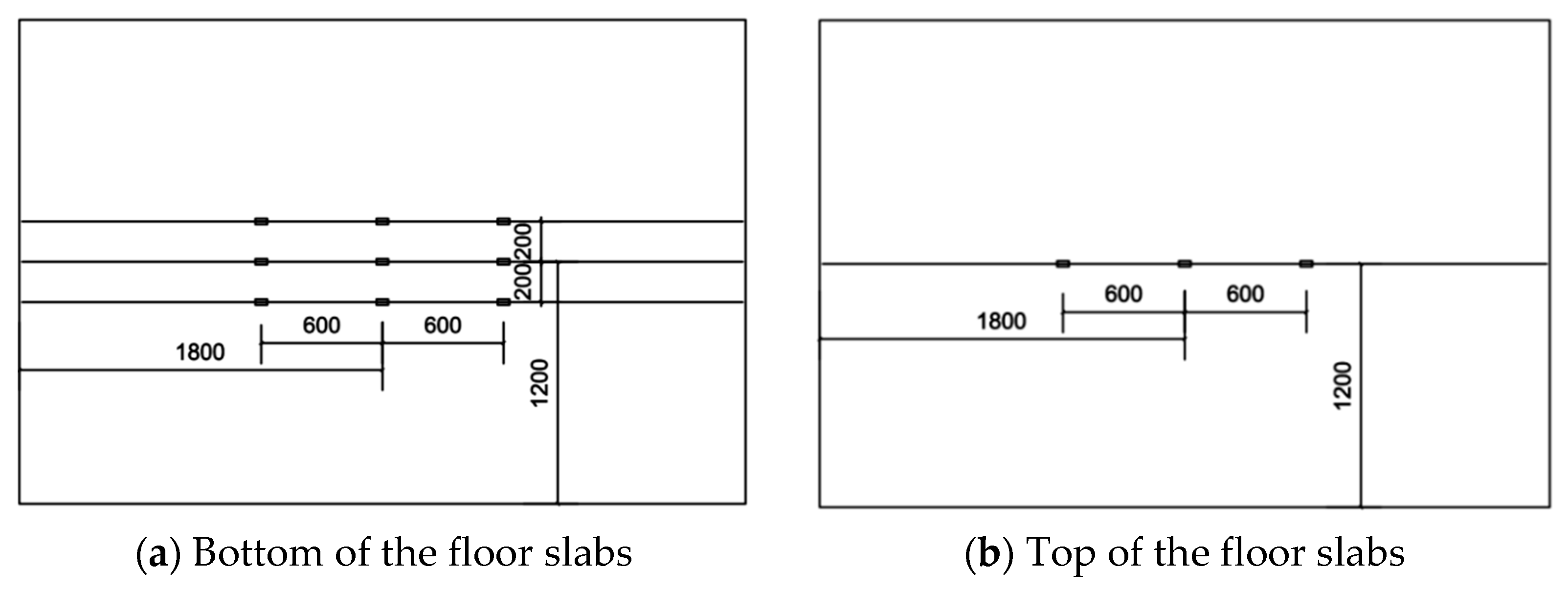
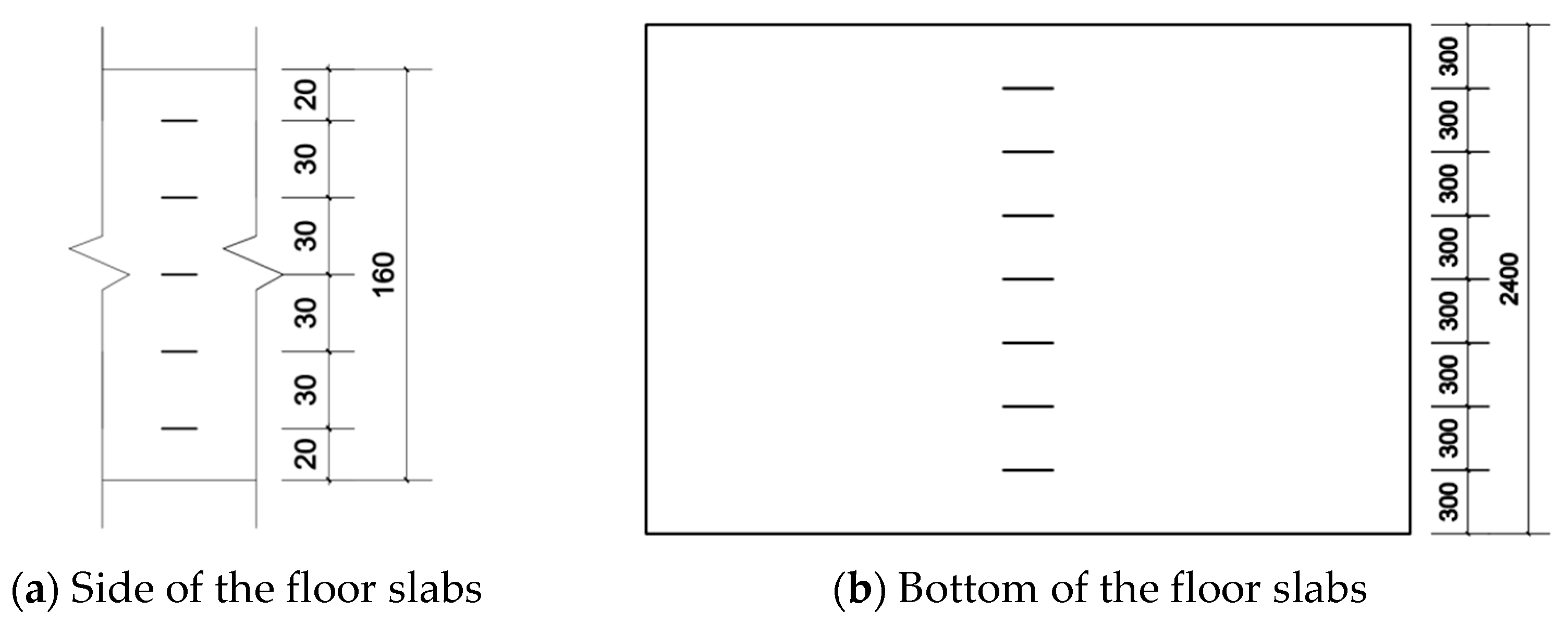


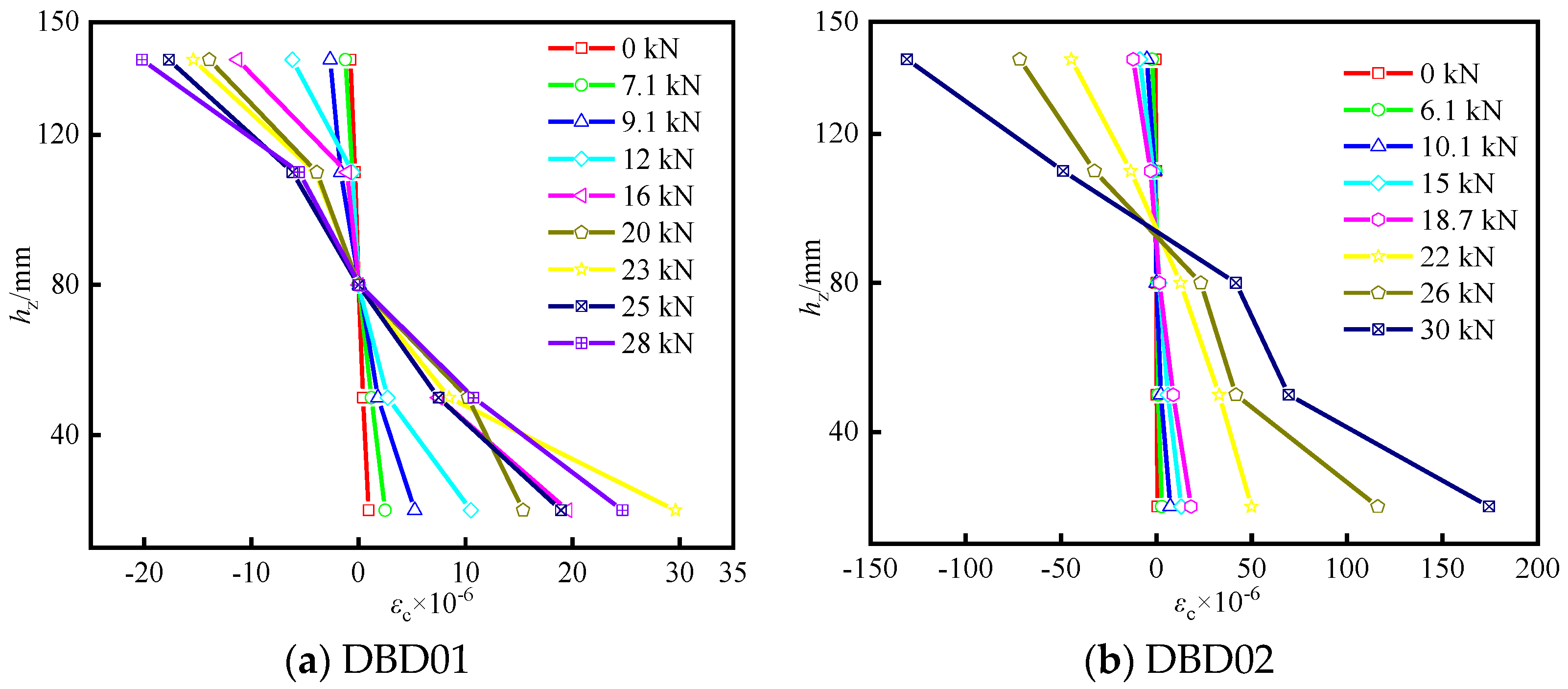

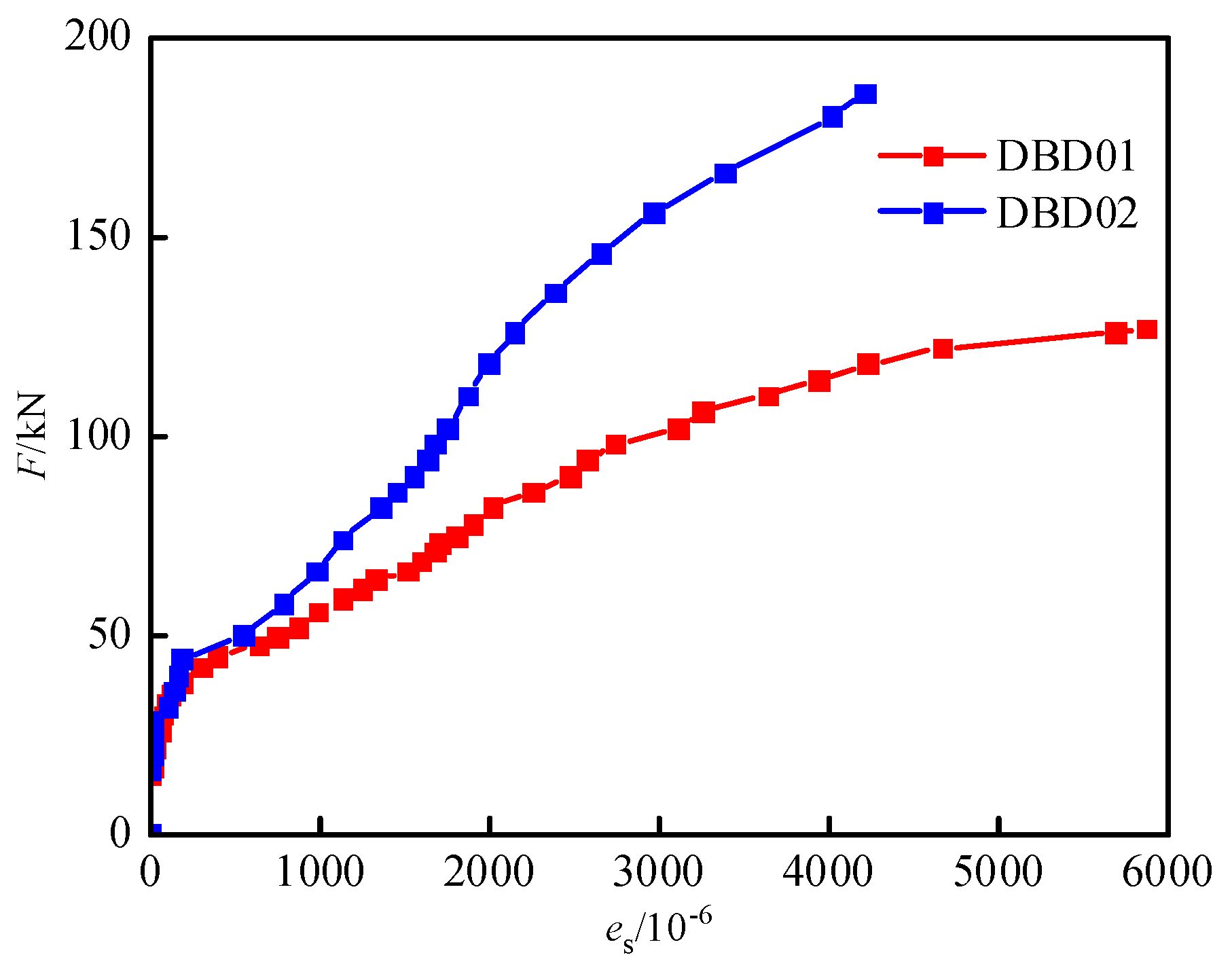


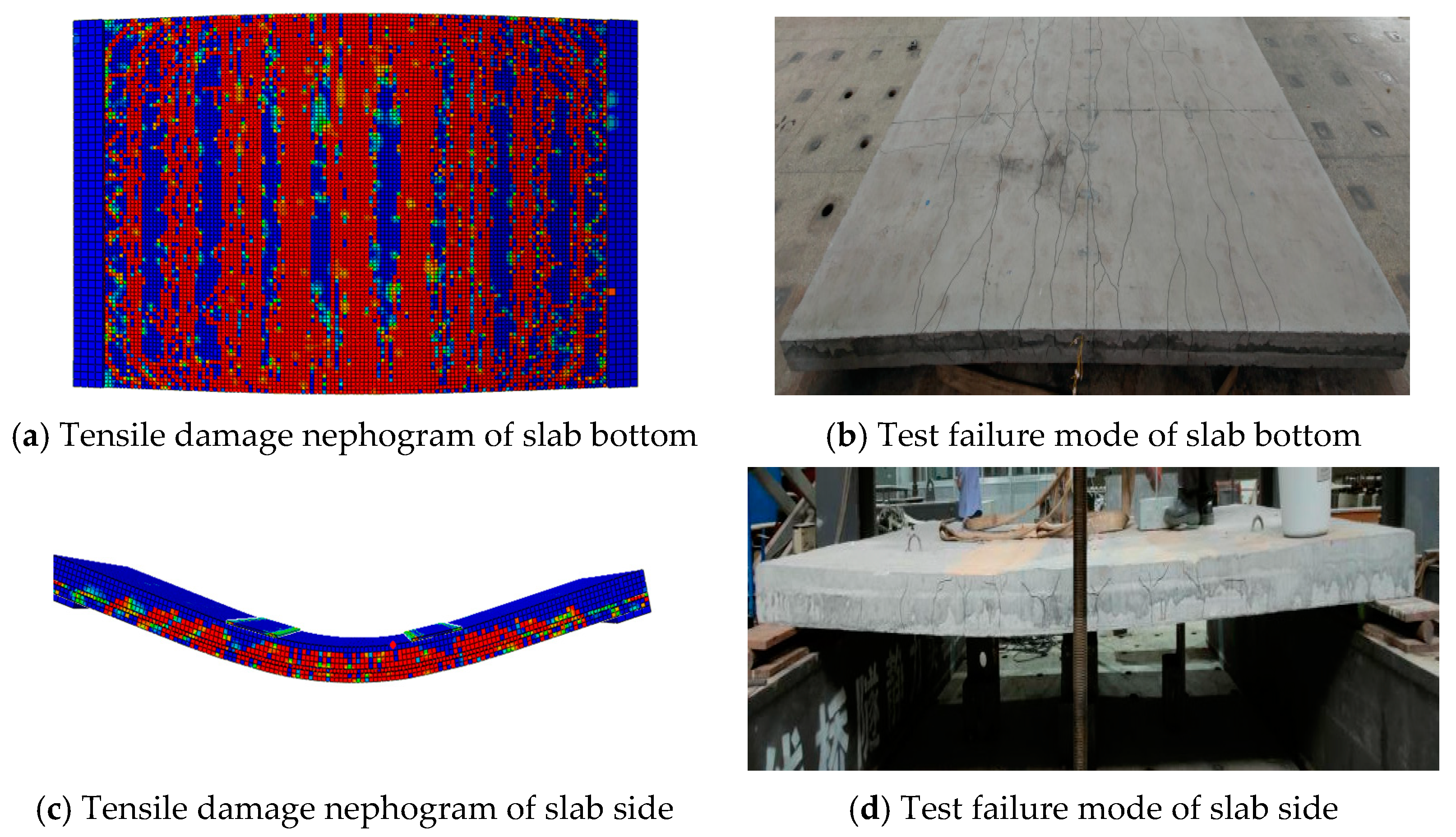
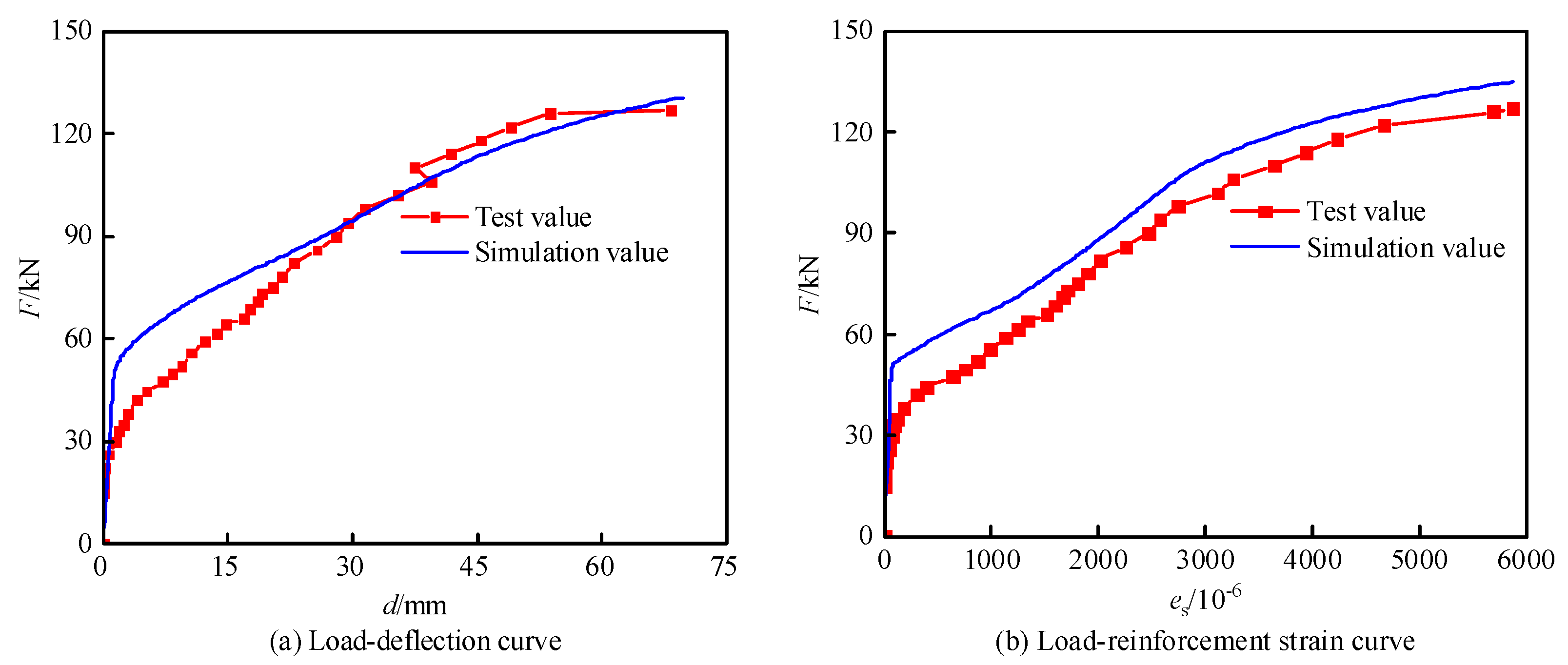

| Specimen Number | Size (mm) | Transverse Rebar | Longitudinal Rebar | Face Rebar | Stirrup Rebar | Rebar Ratio ρ/% |
|---|---|---|---|---|---|---|
| DBD01 | 3600 × 2400 × 160 | ARH6@200 | ARH8@200 | C8@150 | A6 | 0.26 |
| DBD02 | ARH8@100 | 0.50 |
| Reinforcing Steel Type | fyk (N/mm2) | fstk (N/mm2) | Es (N/mm2) |
|---|---|---|---|
| CRB600H | 540 | 600 | 190,000 |
| HRB400 | 400 | 540 | 200,000 |
| HPB300 | 300 | 420 | 210,000 |
| Type | Measured Value of Compressive Strength of Prefabricated Layer (MPa) | Measured Value of Compressive Strength of Laminated Layer (MPa) | fc (MPa) | Ec (MPa) |
|---|---|---|---|---|
| DB01 | 49.2 | 48.7 | 26.8 | 32,500 |
| DB02 | 48.3 | 48.8 |
| Type | Pcr (kN) | P1/200 (kN) | Py (kN) | Pu (kN) | Pcr/Pu | Pl/200/Pu | Py/Pu |
|---|---|---|---|---|---|---|---|
| DBD01 | 13 | 66 | 102 | 127 | 10.24% | 51.97% | 80.31% |
| DBD02 | 39 | 102 | 156 | 186 | 20.97% | 54.84% | 83.87% |
| Specimen Number | Before Cracking | At Limit State | |||||
|---|---|---|---|---|---|---|---|
| Mcs (kN·m) | Mcr (kN·m) | |(Mcs−Mcr)/Mcs| | Mut (kN·m) | Mun (kN·m) | Muf (kN·m) | Mut/Muf | |
| DBD01 | 7.3 | 6.9 | 6.1% | 71.8 | 12.5 | 128.7 | 55.7% |
| DBD02 | 22.0 | 22.5 | 2.1% | 105.1 | 15.5 | 169.5 | 62.0% |
| Specimen Number | Characteristic Load | Measured Value | Simulated Values | |Simulated Values-Measured Value|/Measured Value |
|---|---|---|---|---|
| DBD01 | Pcr (kN) | 13 | 24 | 0.46 |
| P1/200 (kN) | 66 | 79 | 0.16 | |
| Py (kN) | 102 | 109 | 0.06 | |
| Pu (kN) | 127 | 130 | 0.02 |
| Concrete Strength of the Post-Cast Layer | C30 | C35 | C40 | C50 | C60 |
|---|---|---|---|---|---|
| P1/200 (kN) | 80 | 80 | 80 | 83 | 85 |
| Pu (kN) | 131 | 131 | 132 | 134 | 134 |
Publisher’s Note: MDPI stays neutral with regard to jurisdictional claims in published maps and institutional affiliations. |
© 2022 by the authors. Licensee MDPI, Basel, Switzerland. This article is an open access article distributed under the terms and conditions of the Creative Commons Attribution (CC BY) license (https://creativecommons.org/licenses/by/4.0/).
Share and Cite
Liu, P.; Xie, S.; Liu, L.; Luo, A.; Zhang, N.; He, S.; Wu, Y.; Xu, W.; Chen, Y.; Yu, Z. Research on Bending Performance of Concrete Sandwich Laminated Floor Slabs with Integrated Thermal and Sound Insulation. Coatings 2022, 12, 1075. https://doi.org/10.3390/coatings12081075
Liu P, Xie S, Liu L, Luo A, Zhang N, He S, Wu Y, Xu W, Chen Y, Yu Z. Research on Bending Performance of Concrete Sandwich Laminated Floor Slabs with Integrated Thermal and Sound Insulation. Coatings. 2022; 12(8):1075. https://doi.org/10.3390/coatings12081075
Chicago/Turabian StyleLiu, Peng, Sisi Xie, Lei Liu, Ao Luo, Ning Zhang, Sasa He, Yingye Wu, Wen Xu, Ying Chen, and Zhiwu Yu. 2022. "Research on Bending Performance of Concrete Sandwich Laminated Floor Slabs with Integrated Thermal and Sound Insulation" Coatings 12, no. 8: 1075. https://doi.org/10.3390/coatings12081075





